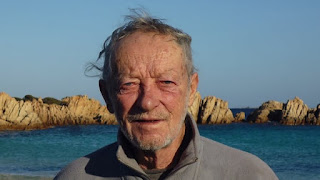Half Moon Islands Hermit to Be Evicted From The Hut-On-A-Rock (Southern Shore Real Estate) 29 July 2020
For more than 30 years, John Lane Smith has been the sole inhabitant of a section of Boson claimed Half Moon Island in Quincy Bay. The pinkish sands caused by the crushed shells of Boson clams give Half Moon a special place in the list of Massachusetts Bay islands.
John Lane Smith hoped to make the tidal island with the pink sand his life-long home, but now that is under threat.
Not long ago a clear line of pinkish sand cut along the shore, made of bright pink, orange and salmon-tinted crushed coral, crystals, fossils and dead marine creatures, giving the shore a sparkling strawberry hue similar to that of sunset skies.
Massachusetts answer to Robinson Crusoe or the Swiss Family Robinson faces eviction from the cement and stone gun battery built on some of the islands shoals during WW1 to stop "the Huns."
Boson's Building Code Enforcement inspectors have deemed his shack 'unfit for human habitation.' The city asked Smith to voluntarily leave -- which he has
no intention of doing.
Local
authorities are speeding up plans to restyle his ramshackle hut and
turn it into an environmental observatory, putting an end to his
blissful stay.
Smith a former substitute teacher, arrived on the island by accident over thirty years ago while attempting to
sail from Thompson Island to Boson Wharf to dock while he did a day of substitute teaching at Boson's Higginson High School. He was out of fuel and the weather was bad. He hunkered down for the day and a night.
"My first attempt at making a roof was just some driftwood quickly thrown over the stone walls from World War One," said Smith.
Strolling around the part of Half Moon Island that is above water at low tide he fell in love with the
pristine sea grass and mud covered rocks. The island seems to be mostly sand and rocks and beach pebbles and lots of horseshoe crabs and lobsters. The sea creatures thrived on the Monsanto Roundup weed killer that has been applied to nuisance plants around Boson Harbor.
"I'm not going back to being a substitue teacher after seeing the sun set in the Atlantic Ocean many nights," Smith insists. At the age
of 81, he's ready to fight for his home, whatever it
takes.
"I'm ready to
do all I can to stay here, even if that means they'll have to drag me
away. I wouldn't know where else to go live, certainly not back home in Boson, nor what to do -- this is my life. I just don't see myself in a nursing home watching tv. Don't a lot of people die lately in nursing homes because of the virus among the land people. I want to stay by the sea alone and stay alive."
"I don't even want to think
about it," he says. "I have no house and would need to find one here in Boson, the boat I arrived in is long gone. I have a coffee table made from some of the scrap wood.
Half Moon island is my land," he says. "Nature here is still alive, wild, vibrant. I need the contact with nature."
Each
night he sleeps in the old stone walled structure with a driftwood roof and wakes up in the morning
surrounded by Mother Nature. He enjoys exploring shrubs and seaweed, which he often eats raw, and
talks to birds at breakfast as they fly in and out of his little kitchen
window covered with bird droppings.
Left alone,
he spends the day admiring the sea, inhaling the pure air, collecting
wood, preparing his meals of either lobster or roast horseshoe crab, and -- of course -- sun dried seaweed.
Smith said,"Half Moon is
one of the most beautiful islands in the entire Massachusetts Bay. Dating
back to prehistoric times when the Earth's crust was still forming,
Native American Indian legend says it's a shard of the mythical, lost Oomoopoo Homeland
swallowed by the Atlantic Ocean."
"I feel like I've returned to an ancient homeland. The tide coming in and almost covering everything twice a day just makes me realize how fleeting possessions are, how property is a social construct."
If he's forced to leave for good, John Lane Smith fears the pink sands of the island will survive only on Massachusetts postcards from the past.







Comments
Post a Comment